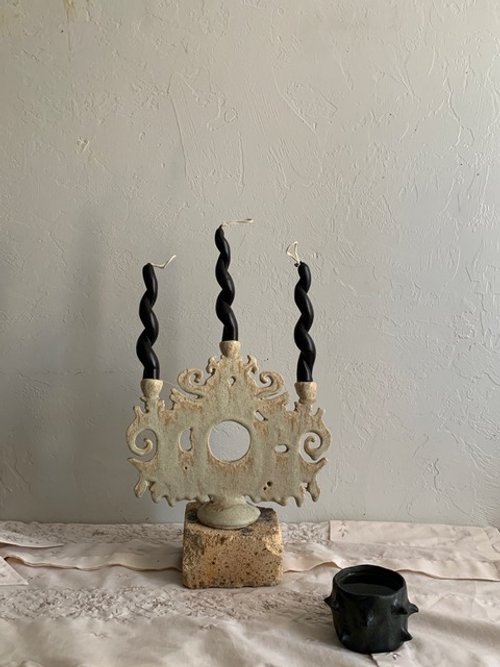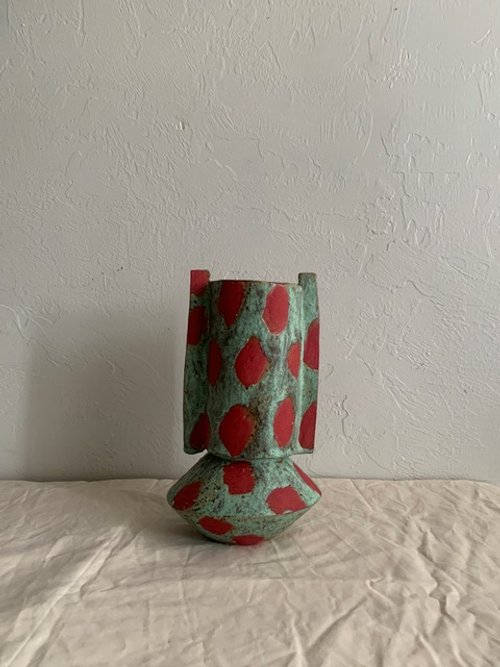Meet the Maker: Isaac Diaz of Uoqaus
In this series of features, we catch up with the ceramic artists we work closely with and share introspections into their creative processes.
Isaac of Uoqaus (an adaptation of a Finnish word “huokaus,” meaning “to sigh”) is based in Oklahoma City, Oklahoma, and he explores the relationship between ceramics and people. Taken from his website, “both are uneven and imperfect, yet made of earth. While looking to these connections, Uoqaus also reinterprets ancient stories and traditions. Uoqaus mostly finds inspiration through the old, and alive, cultures of Latin America. Uoqaus is a sigh of what can be, a desire for something else while creating that ‘something else.’”
Isaac Diaz of Uoqaus.
What does a typical day in the studio look like for you?
ISAAC: I work in a communal studio space, so I often have to plan my days when I can go in. I try to set aside 8-12 hours a week to work on my pieces. I usually start around 10am and finish around 2pm. Regardless of how long I am there, I work until I am tired or until it is time to stop touching the pieces in progress. I am probably listening to music or a podcast. I always have plans and deadlines I set, but I never plan my daily studio routine—I start and finish things as they come.
Most of your clay works are hand-built. How did you come to choose this over working on a wheel? What are some unique elements to hand-built work that you enjoy?
ISAAC: Handbuilding just came naturally to me. I have always been into organic shapes, old broken things, and seeing the human touch in anything. I find throwing to be too mechanical. I think my ideas lend themselves better to something that isn't quite symmetrical or smooth. Handbuilding is unique in that anyone can do it. It is probably one of the oldest forms of art making, and you really just need clay, and that's all.
One of Isaac’s showings of his pieces.
Most of Isaac’s work is hand-built, meaning it fully embraces irregularities, asymmetry, and a rough-hewn look.
You had a residency last year in Mexico—what was that like in terms of experiences, both clay and personal? Do you foresee yourself doing anything like that again?
ISAAC: In 2021, I attended a 6-week Pre-Columbian ceramics course at Arquetopia in Puebla, Mexico. It was both a familiar, yet unfamiliar experience. It was my first time in Mexico, and I got to see how different things are there in comparison to my only other experience in Latin America being in El Salvador. It felt like my teacher was truly connected to his practice and the materials. Everything—the clay, the slips, and the colorants—was processed by hand, and then fired in handmade wood kilns. Personally, it made me realize I can do a lot on my own, and I am not afraid of making mistakes in my Spanish, or even getting lost while exploring a city. I see myself applying for more experiences like this—they can connect you to artists from all over the world, and it helped me rethink my practice and what I want from it.
A candlestick holder of Isaac’s, crafted with great attention to detail and intention—the soft and ornate form is juxtaposed when paired with the black vessel with protrusions emerging from it.
One of Isaac’s wall pieces, intended to hold candlesticks as well.
What are your biggest influences when creating work? What in particular do you draw inspiration from?
ISAAC: Definitely the cultures of Latin America. From old Mayan pots, to wrought iron window frames, I love it all. I also look at a lot of Hindu art—the colors and imagery are captivating. I think old, ancient art from across the world is what really interests me. The passage of time on things makes them better.
When creating planters, is there anything in particular you consider?
ISAAC: I always think about how the clay will look on its own. I mostly keep planters unglazed, as I love the look of old, dirty terracotta. Also, one thing that can keep me sketching is how the drip plates will look with the planter itself.
A coiled, rope-like candlestick holder meant to be hung on walls.
Another of Isaac’s installations/showings with pieces of various dimensions on display.
What are your favorite words to live by?
ISAAC: “Do not be wasteful.” Waste is something I always think about when I am doing anything.
Your home base is currently in Oklahoma—what do you like most about the community around you there?
ISAAC: I like that it's a small community. I think a lot of people mistake Oklahoma/The South as an artless place, but truly there are people doing interesting things here. Whenever you have a show or go to an art show, so many people you recognize show up. There is a lot of support within the community.
Isaac holding one of his hand-built vases.
One of Isaac’s vases, featuring a turquoise glaze with contrasting bright red details.
How do plants play a role in your life? Do you keep any in your studio space? If so, are there specific ones you are drawn to?
ISAAC: I have a few plants at home. Mostly cacti and a staghorn fern I rescued from a grocery store in the sale area. I think they add a touch of life into our homes and spaces. It is nice to see how each plant I have has grown. I love staghorns and air plants—ironically I have killed quite a few air plants... don’t ask, because I know they are easy to care for. I have had my eyes on a Fire Sticks plant for a while.
What would your advice be for anyone interested in making ceramics?
ISAAC: Take a class first. I think having someone who can guide you in person can be much more helpful than videos or courses online. Also, don't worry about perfection. Clay will shape itself according to your own unique set of hands—embrace it. While it might sound a little negative, expect everything you make to crack, break, melt, warp, be dropped, or fall apart. You can remake anything, and each time you do, you teach yourself new techniques.
Photos provided by Isaac Diaz.









